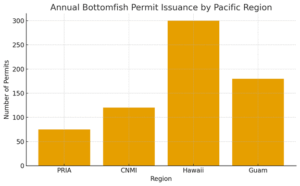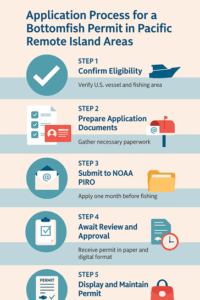The Pacific Remote Island Areas Bottomfish Permit is a vessel permit to allow commercial fishing. It is also used for allowing fishing vessels to operate in the Pacific Remote Island Areas (PRIA). It is used for helping to control and manage a sustainable bottomfish fishery on the islands and in the associated federal waters through the authority of the National Oceanic and Atmospheric Administration (NOAA).
The PRIA includes the islands themselves. The PRIA includes also the waters that surround Baker Island, Howland Island, Jarvis Island, Johnston Atoll, Kingman Reef, Palmyra Atoll, and Wake Island. The United States claims jurisdiction over all these territories, which have sensitive marine ecosystems. The Bottomfish Permit is a regulatory requirement that applies to the bottomfish fishery.
This guide explains the purpose of the Pacific Remote Island Areas Bottomfish Permit, who can apply and how they apply, what the permit requires, and how industry can best conduct business legally in one of the least impacted marine ecosystems on Earth.
Understanding the Pacific Remote Island Areas Bottomfish Permit
The Pacific Remote Islands Areas Bottomfish Permit allows vessel harvest of deep water bottomfish species from Exclusive Economic Zone waters in and around the U.S. Pacific Remote Island Areas (PRIA). The National Oceanic and Atmospheric Administration Pacific Islands Regional Office handles the permit within.
| Aspect | Details |
|---|---|
| Administering Authority | NOAA Fisheries Pacific Islands Regional Office |
| Purpose | Regulation of bottomfish harvest in PRIA waters |
| Eligible Applicants | U.S.-registered vessel owners |
| Permit Validity | 1 year (renewable) |
| Target Species | Deepwater snappers, groupers, emperors, and other bottomfish |
Importance of the Permit – Pacific Remote Island Areas Bottomfish Permit
- Sustainability: Fishing pressure is regulated through laws. This prevents depletion of bottomfish stocks.
- Legally comply: Ensure adherence to U.S. federal fisheries law.
- It maintains the unique ecosystems across PRIA.
- Data Collection: Providing core catch data toward management and research.
The permit operates under the Pacific Islands Fishery Ecosystem Plan or FEP and has a goal of the environmental sustainability of fishing activities over the long term.
Regulatory Framework and Legal Requirements
Federal fisheries regulators issue the PRIA Bottomfish Permit under the Magnuson-Stevens Fishery Conservation and Management Act (MSA) to control, monitor, and ensure the sustainable harvest of bottomfish in the PRIA.
Key Legal Provisions – Pacific Remote Island Areas Bottomfish Permit
- Authorized Zones: Fishing occurs only in certain waters within the PRIA EEZ.
- Prohibited Practices: fishing is banned from Marine National Monuments and restricted conservation zones.
- Reporting Requirements: Fishermen must record catch data and must submit reports within time intervals.
- Inspection and Enforcement: The NOAA and U.S. Coast Guard inspect all vessels for assurance that environmental regulations are followed onboard.
Documentation Required for Application
To apply for the permit, applicants must provide:
- Completed NOAA Fisheries Permit Application Form.
- Proof of documentation or registration of vessel.
- Proof of ownership or lease agreement.
- Vessel specifications and safety compliance details.
- Pay the prescribed fee.
Description of Requirement
To qualify for the program, the vessel must have a U.S. Coast Guard certificate of documentation or a state registration, prove ownership through ownership records under an active charter agreement, and comply with all relevant federal safety regulations. The participants must commit to reporting so they ensure the logs maintain properly and submit in a timely manner.

- A bar graph compares the number of bottomfish permits issued on an annual basis throughout the four regions of the Pacific: PRIA, CNMI, Hawaii, and Guam.
- The most permits come from Hawaii 300. It operates the largest commercial and local bottomfish fleet.
- Following it are Guam (180), which has the most nearshore, reef fishery permits proportionally.
- CNMI issues 120 total permits, placing it in the middle tier among regional bottomfish fisheries.
- Overall, PRIA has the fewest permits, with 75, because accessibility is low and the fisheries are relatively small.
- On a Pacific-wide scale, the number of permits issued is affected by the particular demand for fish and the size of boats.
The graph shows that, in contrast with larger fisheries such as Hawaii, PRIA has a smaller number of active permits due to its conservation policies and limited commercial fisheries.
Application Process for Pacific Remote Island Areas Bottomfish Permit
Getting a permission requires the processes of application and approval to be passing through different stages before finally getting the proper documentation.

Step 1: Confirm Eligibility
Applicants must ensure their vessel is:
- Registered under U.S. documentation.
- May be fished for bottomfish using longline, hand line, or other gear.
- In PRIA federal waters.
Step 2: Prepare Application Documents
Gather and verify all required documents:
- NOAA PIRO application form.
- Vessel documentation certificate.
- Owner ID and proof of address.
- Previous catch records (if any).
- Receipt of processing fee payment.
Step 3: Submit to NOAA PIRO
Applications may be submitted electronically or by post and must be received not less than one month before the date on which it is proposed to fish.
Step 4: Await Review and Approval
Next, NOAA evaluates the vessel’s compliance history, overall performance, and the environmental impacts caused by the operation. Based on that, the agency officially issues the permit to the vessel both in hard copy and in digital formats.
Step 5: Display and Maintain Permit
The permit must be:
- Onboard the vessel.
- Available to be seen at any point.
- Must be renewed before expiration to remain legal.
Responsibilities and Compliance Obligations – Pacific Remote Island Areas Bottomfish Permit
Operators are required to keep accurate records and follow stringent conservation methods as per the Pacific Remote Island Areas Bottomfish Permit.
Reporting Requirements
Permit holders must submit detailed reports including:
- Daily catch volumes by species.
- Fishing location coordinates.
- Gear type and fishing effort.
- Bycatch and discards information.
These reports constitute the foundation of NOAA’s ecosystem-based fishery management system.
Seasonal and Area Restrictions
To protect the spawning of fish or for other species-specific reasons, fishing is not allowed in ecologically sensitive areas such as marine reserves around some of the PRIA islands, at certain times of the year.
Penalties for Non-Compliance
If an individual is found to be engaged in illegal fishing, misreporting of catches, or fishing activities without a valid fishing permit, he or she may be punished.
- Hefty federal law penalties.
- Permit suspension or revocation.
- Legal prosecutions under the Magnuson-Stevens Act.
| Violation Type | Penalty |
|---|---|
| Unpermitted Fishing | Up to $140,000 fine |
| False Reporting | Permit suspension |
| Fishing in Restricted Zones | Revocation and fine |
| Safety Non-Compliance | Temporary ban until resolved |
Best Practices for Permit Holders – Pacific Remote Island Areas Bottomfish Permit
To maintain compliance and efficiency, operators should implement the following best practices:
- File Reports Promptly: Submit all required catch data on time.
- Review area maps regularly. Check around no-fishing zones or seasonal closures.
- Equipment Standards: Regular inspections ensure safety and that equipment complies.
- Plan Renewals Early: Start the renewal process at least 30 or more days before the expiration date starting now.
- Promptly report. Comply with gear rules to discourage bycatch. Also discourage disturbing habitats. Discourage gear loss and over-extracting resources. Furthermore, frequent observations allow for the early detection of vessel problems, which can contribute to continued viability of their operations and safety. Transparent strong data also may help build credibility among regulators to access fisheries in the future.
Safeguarding the Pacific Through Responsible Fishing
The Pacific Remote Island Areas Bottomfish Permit was intended to protect the ecosystem and ensure people living in U.S. Pacific territories would continue to have access to fish. Fishing businesses protect ocean resources for future generations by complying with NOAA’s regulations.
Although the permit process is complex, it ensures fair access and responsible resource use. Transparent, proactive management of the PRIA Bottomfish Permit system helps officials balance economic growth with the environmental protection of the Pacific’s most sensitive areas.


No Comments
Be the first to start a conversation